Booting Phoenix Os Trying to Terminate Ef Services Again
Want to make an Android PC? Information technology's like shooting fish in a barrel. Phoenix Bone, based on the Android-x86 project, can install Android on a desktop (or laptop). On the downside, it won't run the full version of Chrome browser (Chrome is really fast). This is, later all, a mobile operating system.
Hither's how to go started with an Android Bone for PC.
Warning: The instructions in this guide will OVERWRITE your hard bulldoze. While Phoenix OS tin can install in a dual-kicking configuration, I don't recommend it considering dual-booting can crusade problems with both operating systems.

Android PC Using Phoenix OS
Phoenix Os looks and feels a lot like the now unsupported Remix OS. Information technology's GPL-2.0 compliant and installs on many different kinds of x86-based hardware. (If you can install Linux on a specific reckoner, you tin can probably install Phoenix Bone.)
Phoenix Bone likewise includes improvements to Android, such as automatically preventing apps from running in the background. In improver to speed, the OS besides receives regular updates. These features have contributed to its contempo increase in popularity. A few Prc-merely hardware companies will release tablets and miniPCs with Phoenix OS as its primary operating system -- for example, the Pipo P10 2-in-one tablet.
Not all hardware is (fully) compatible with Phoenix OS. In many ways, information technology suffers from the aforementioned weakness and shortcomings every bit Linux: namely that it won't piece of work with all hardware. And even when it does piece of work, it will lack certain features, like audio through an HDMI connectedness.
As an aside, y'all tin test Phoenix OS out from within a virtual machine, such as VMware or VirtualBox. The Phoenix Os images for both are found over at OSBoxes.org.
Requirements for Installing Phoenix OS
Phoenix Bone Hardware Requirements
Phoenix Bone only requires an Intel or AMD x86 processor (Intel Atom recommended) and internal storage with at least 2GB of space. I recommend using at least 16GB drives. In social club to install Phoenix Os, you will need a USB bulldoze with at to the lowest degree 8GB of storage.
Requirements:
- 2GB storage drive
- Intel or AMD processor made around 2012 or subsequently, preferably an Intel Atom processor
- An 8GB or larger USB flash drive (for Phoenix OS)
- A 512MB or larger USB flash drive (for GParted)
- A split computer in social club to ready the USB flash drives
UEFI or BIOS Motherboards?
Older computers (2010 or older) mostly utilize Basic Input/Output System (BIOS) every bit a Power On Self Examination (POST) surroundings. So, what does that mean?
A BIOS allows computers to get-go without an operating system. Newer computers replace BIOS with something chosen a Unified Extensible Firmware Interface (UEFI), which is more robust compared to the older scheme. Unfortunately, Phoenix Bone doesn't play nice with UEFI systems. And that requires configuring your UEFI to work with a non-Windows operating system (run into step three below.)
Phoenix Bone Installation Instructions
Step 1: Download Phoenix Os
The Phoenix Bone installation packet includes both 32-bit and 64-flake compatibility. That means you can install the operating system on older or newer hardware. Note, though, that the instructions in this guide rely on downloading the ISO image, not the executable.
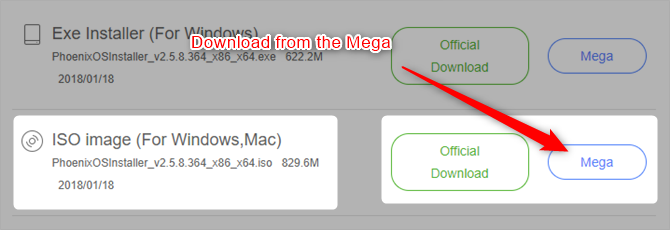
Download: Phoenix Bone
Footstep 2: Image Phoenix OS to USB Flash Bulldoze
Once you've downloaded the Phoenix OS bundle, y'all need to epitome it onto a bootable USB bulldoze using Rufus. Alternatively, yous tin can use UNetbootin, but it tin can cause unpredictable behavior during the installation process.
Download: Rufus Portable [Broken Link Removed]
Next, run Rufus to paradigm your downloaded re-create of Phoenix Os to a USB bulldoze. The USB bulldoze must offer at least 8GB of storage.
Take note of the following: First, select your USB drive. 2d, yous can use GUID Partition Table (GPT), but I had zero success with it. Cull Principal Boot Tape (MBR) instead of GPT. Third, choose FAT32 for the file arrangement. Fourth, make certain you've checked the boxes for Quick format and Create a bootable image using.
The rest of the defaults hither should work.
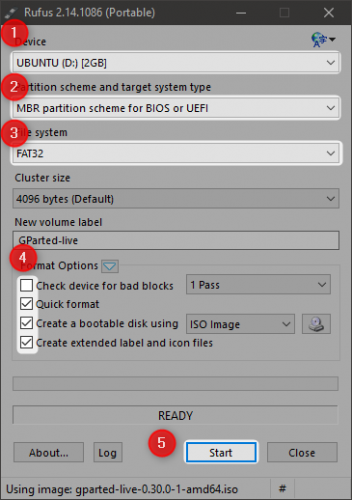
- Select your USB flash drive.
- Nether Partition scheme and target organisation type, choose MBR.
- Check the boxes for Quick format and Create a bootable disk using (and choose Phoenix Os from wherever you lot downloaded the .ISO file).
- The other defaults should work fine. Choose start.
Step 3: Configure Your BIOS/UEFI
Configuring the BIOS/UEFI (BIOS explained) is the hardest stride. You'll besides nee to know how to enter your computer's BIOS. Motherboard manufacturers do not use a common language for their BIOS settings. For example, you lot volition need to turn something called Legacy Mode on.
Unfortunately, dissimilar board manufacturers may utilize unlike language to depict this feature. Additionally, you may demand to disable Windows-specific features. In your POST environment, some manufacturers refer to information technology as Windows 7 mode. Others chosen it Windows 7 or Other Operating Organization Fashion. And in that location are other variations, as well.
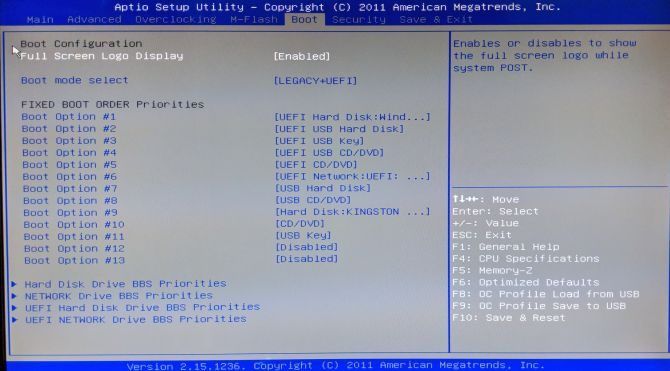
Yous will too want to plough off whatsoever Fast Boot and Secure Boot options. Fast Kick and Secure Boot are designed for Windows computers -- Phoenix Bone is Linux-based so there's no reason to go out them on.
- Turn Legacy Fashion on, if possible.
- Choose Windows vii mode or Linux manner, if possible.
- Turn off Fast Boot and Secure Boot, if possible.
Step iv: Prepare Your Target Drive for Installation (Optional)
Why is this stride optional? The simply reason you demand this step is to change the boot drive's sectionalisation table from GPT to MBR. Many older drives come up with MBR as its sectionalization table as default. If you already know whether or not the bulldoze is MBR, skip this step. I should also note that GPT sometimes works with Phoenix OS. In my experience, though, it does not.
Download GParted for this step. GParted is a partitioning utility. Amid its many features, information technology can prepare a storage drive for receiving an installation of an operating system. The specific function that you need is to format the storage bulldoze's partition as MBR.
Download: GParted Live USB
To format a disk equally MBR, simply image GParted onto a USB drive and boot your calculator with the USB Flash drive inserted. The steps after GParted boots are simple: choose the default options (merely striking enter when prompted).
I won't get into lavish detail here, but you will need to remove the current partitions on your disk and create a Microsoft DOS partition table on the disk. To do and so, cull Device and then Create Partition Table from the context bill of fare.
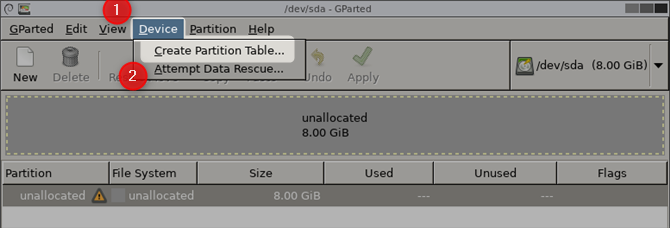
Finally, at Select new partition table type prompt, cull msdos. So striking Use.

That should write the new partition table to the disk. Y'all tin now exit this programme.
Step 5: Fix Your Computer for Phoenix Bone
The installation process is straightforward. First, insert the installation USB drive into your computer and boot from the bulldoze. Remember: the installation process outlined hither is subversive.
Yous should see a bill of fare that looks like this:
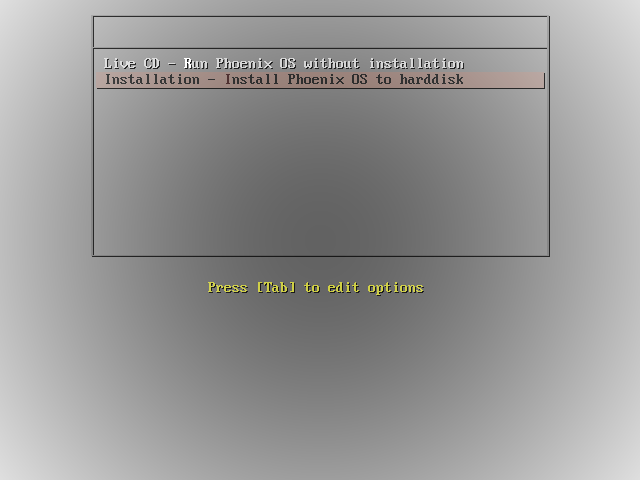
Choose Installation. From the next menu, select Create/Modify partitions. Optionally, if you lot but want to encounter if Phoenix OS works on your system, choose Live CD. If it boots, congratulations, your system is compatible!
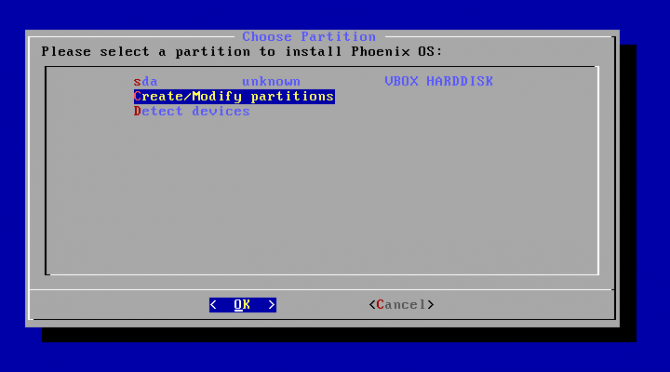
Y'all may receive the prompt Practise you want to use GPT? Choose No. As discussed earlier, using GPT is a disaster on Phoenix Bone.
The following window looks like this:
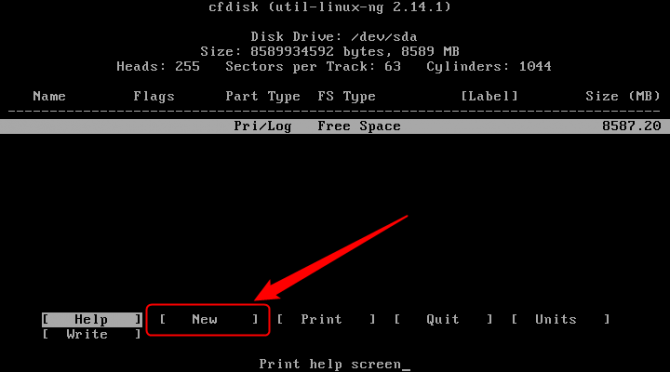
In this carte du jour, you must use the left and right directional keys for navigation.
Commencement, hit the right key to select New and then hitting enter, which creates an entry called sda1. Second, choose Primary and employ the default bulldoze size (which should be the entirety of your drive). Then, third, choose Bootable every bit the last selection. Be conscientious that you don't accidentally remove the Boot flag by pressing enter more than once.
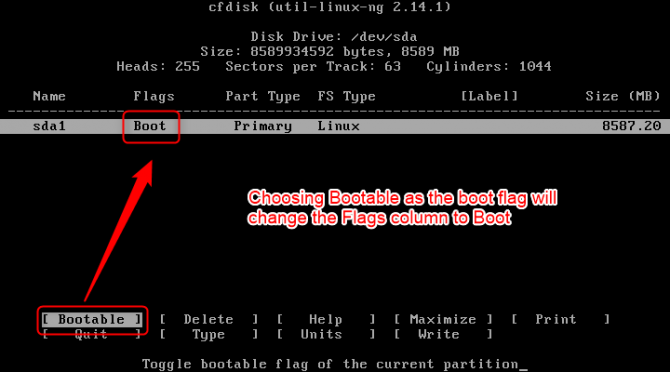
Select Write to commit the changes to your bulldoze. However, only before writing the changes, you'll receive a prompt asking: Are you certain you want to write the partition tabular array to deejay?
Yous must manually type in the word yes and hit enter. Then the format tool writes the tables to disk. After it writes, choose Quit. This returns you to the Phoenix OS partition choice card.
Step half dozen: Install Phoenix OS to the Target Drive
Choose sda1 and striking Enter.
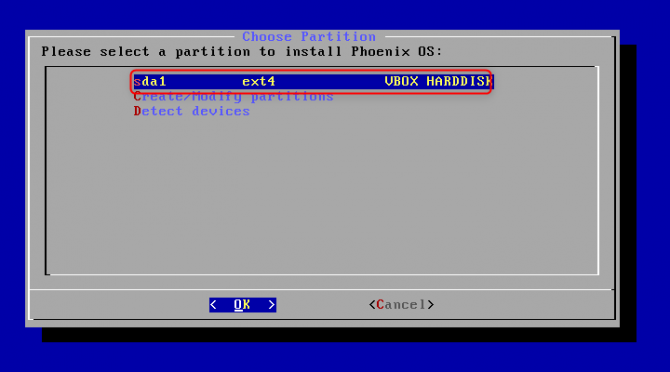
From the Choose filesystem carte, select ext4 as the filesystem.
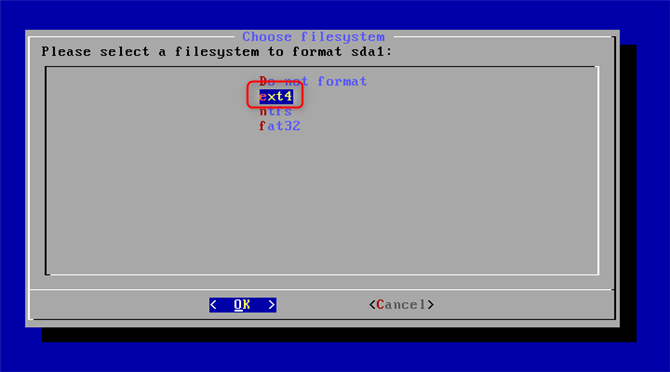
The installer will ask for confirmation (this footstep volition create an ext4 partitioning, which wipes out the previous data on your drive). Choose Yes.
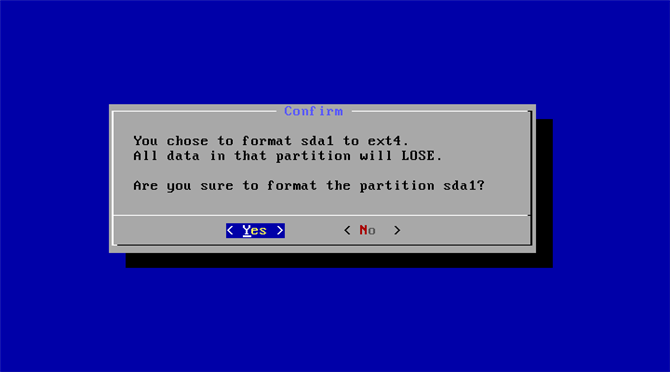
It may ask if you want to install an EFI GRUB2. Considering that your disk should be formatted as GPT, yous will select Skip.
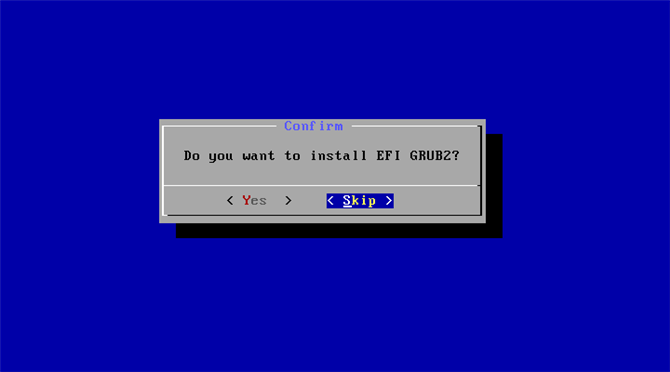
It will then ask: Do you want to install boot loader Grub? Choose Yeah. You're pretty much done at this signal. Later on it finishes installing, you'll see the following bill of fare:
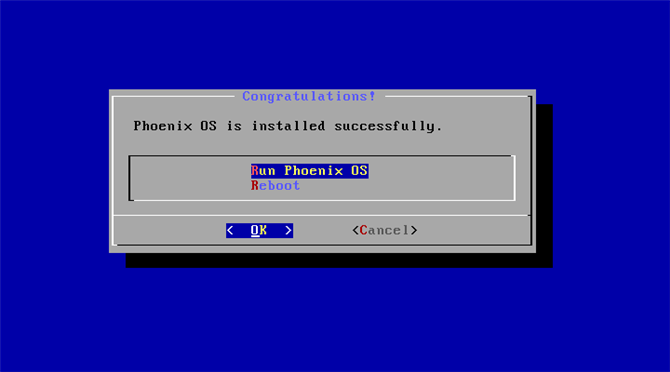
Yous can select either Run Phoenix Os or Reboot. If you choose to Reboot, remember to remove your installation USB drive from the calculator.
Using Phoenix Os as an Android PC
Phoenix Bone Is Nougat + Windows
Phoenix Bone looks similar Android Nougat but with a desktop interface. Most apps open up in windows, meaning they don't occupy the entirety of the screen.
Similar a desktop, Phoenix Os also includes such features as "snap", where you lot can shift a window to the left or right half of the screen. This may not last, though, as Remix OS (how to install Remix OS) offered the aforementioned characteristic and removed it later. I'yard non sure why, only copyright may be the culprit.
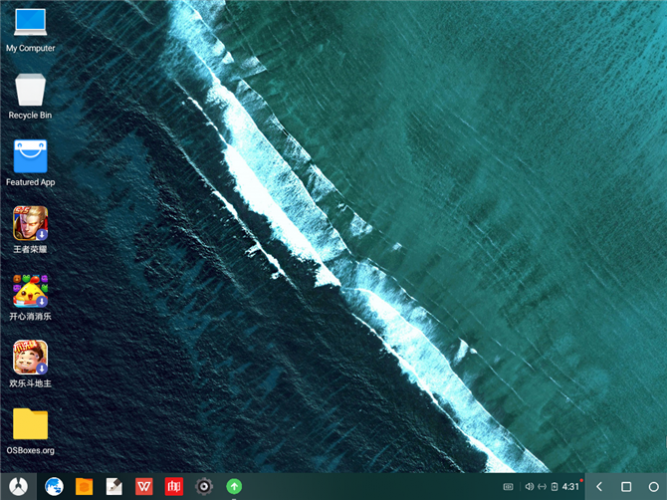
The snap feature allows for Android to part in dual-window mode. To illustrate, opening an app and holding the Windows key (or command key) and hitting either the left or right directional key volition crusade the app to resize and change position. Below is a screenshot of Phoenix OS'due south dual-window mode in action. It's handy for writing papers and more.
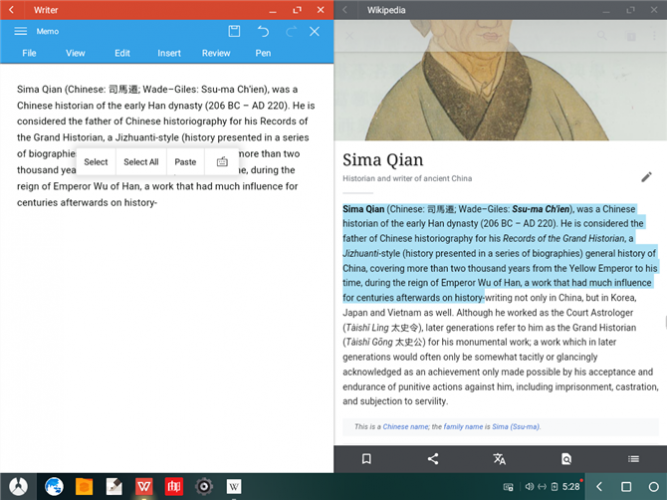
Phoenix OS Limitations
A lot of games won't play correctly using a mouse and keyboard interface. And on acme of that, there are a few features that need smooth. For case, if you desire to highlight large swathes of text, yous have to click, hold, and then manually select the text you want. It'due south iii times every bit time-consuming compared to a Windows or Mac computer.
Even though Phoenix OS'due south developers designed the operating system to piece of work on Atom-based systems (best Linux distributions for Atom processors), it will still install on most newer computers. I should note, though, that virtually computers will boot, but they won't piece of work properly with Phoenix Os installed. For example, HDMI audio rarely works.
Should Y'all Install Phoenix Bone?
If you have a figurer with an Cantlet-based processor, like a netbook, information technology's worth trying out. Phoenix OS has two big advantages: first, it'south fast. 2nd, it gives you access to the Android app library.
The issue with Phoenix OS is that information technology doesn't work on every computer the mode Windows does. And then a lot of people will install information technology thinking it can make older hardware faster. It tin, just rarely does it piece of work without issues.
Do y'all beloved using Android on a computer? Permit us know in the comments.
westmagnstowiter1963.blogspot.com
Source: https://www.makeuseof.com/tag/android-pc-phoenix-os/

0 Response to "Booting Phoenix Os Trying to Terminate Ef Services Again"
Post a Comment